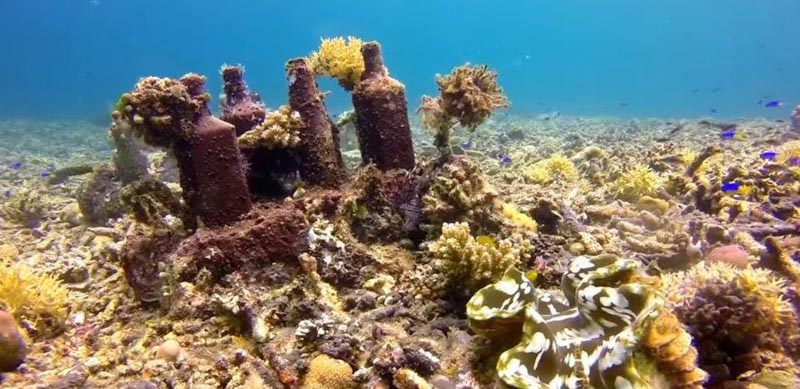Take one look at your reef tank and you won’t have to look far to find a frag plug. While most of our corals come on ceramic discs or squares, frag plugs come in all shapes and sizes.
Frag plugs are used to fix smaller fragments of coral into place so they will continue growing into larger corals. In our homes, we use artificial branching rocks, glass bottles, and even skulls to grow corals, so what happens when you take these ideas and use them to rebuild damaged coral reefs in the wild?
There are several threats to corals whether in our reef tanks or in the ocean. In our reef tanks changing ocean (water) conditions and predatory fish or invertebrates, may pose a bigger threat while in the wild corals also have to contend with tropical storms, sediment runoff, overfishing and destructive fishing like dynamite fishing blasting.

In remote locations the loss of coral reefs, due to natural or illegal activities, can have a devastating impact on local fish population, however if actions are taken corals can regrow quickly bringing fish and life back to the communities who rely on these resources.
On the Island of Sabah in Malaysia (Borneo), the Tropical Research and Conservation Center (TRACC) has been regrowing damaged coral reefs using, plastic bottles, plastic crates, empty beer bottles, and eco-friendly cement. Over three years, scientists, students, divers, Malaysian and International volunteers have been building reefs and have seen an increase in fish and corals, including new fish species to the area.

From the video episode of Borneo from Below, Professor Steve Oakley, founder of TRACC, David McGuire, marine conservationist and founder of Shark Stewards and presenter Aaron ‘Bertie’ Gekoski shows us how TRACC has encase glass bottles in cement and built three types of artifical reefs which TRACC calls Bottle Case Reefs, Step Reefs or Ribbon Reefs.
We especially like the step reef design for two reasons, having the space between bottles, beneath each step is a great hideout for juvenile fish, and the use of simple recycles building materials make this an eco friendly (and budget friendly) approach to coral restoration. The Ribbon Reef design is the most reminiscent of our home reef tanks, TRACC has used a combination of glass bottles and cement frag discs and squares, creating an underwater ribbon of coral in damaged rubble beds.

We have seen many forms of reef restoration in the wild, and admire those who think outside the box to develop simply restoration solutions that work. These cement and bottle reefs could be deployed quickly once a reef has been dynamited, or suffered damage from a storm, a fishing net or an anchor, making it possible to save broken coral fragments before it’s too late. Like our reef tanks, even the small frag plug style discs could be grown in a protected or controlled area then transported to build new reefs.
https://youtu.be/vZDuPm4bNM8



